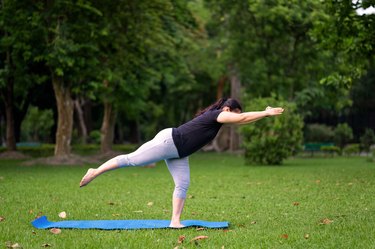
When it comes to birth control and your workout routine, most of the chatter is about how to exercise when you are pregnant, not if you're trying to prevent pregnancy. But you actually do need to think twice before working out after an IUD insertion — at least in the very short term.
Below, ob-gyns answer all your questions about exercising after getting an IUD, including how long you should wait to exercise after IUD insertion and whether exercise can dislodge an IUD.
Video of the Day
Video of the Day
When Can I Exercise After IUD Insertion?
You should wait 24 hours after IUD insertion before hitting the gym, according to Felice Gersh, MD, author of PCOS SOS: A Gynecologist's Lifeline To Naturally Restore Your Rhythms, Hormones and Happiness. "After either hormonal or non-hormonal IUD insertion, the standard recommendation is to wait one day before exercising," she tells LIVESTRONG.com.
To understand why experts recommend against bopping from the doctor's office to the studio, you need to understand the insertion process. Dr. Gersh says: The IUD, or intrauterine device, gets inserted into the uterine cavity. To access the uterus, doctors insert a thin tube (or slider), which contains the IUD into the teeny-tiny hole in the cervix (the anatomical "end zone" of the vaginal canal).
Once the slider is in place, a plunger inside the slider is used to push the IUD into place in the uterus. Then, the slider is removed from the vaginal canal while the IUD is left behind, she explains. Viola!
This is a pretty minor procedure. But a "foreign object" is being placed inside the uterus. So, some people experience pain or cramping for a few hours afterward, as the body adjusts to the feeling of the device, according to Dr. Gersh.
Actually, mild cramping immediately following insertion is the most common symptom, she says. "The uterus is basically a big ball of muscle, and just as other muscles can cramp, so can the uterus."
Waiting a day to return to exercise helps keep cramps from worsening, she says. "And it gives time for the body to adjust to having a foreign object in it."
Can Exercise Dislodge An IUD?
No. There is no evidence exercising immediately following insertion can cause the IUD to shift inside your uterus, or cause the IUD to expel from your body completely, Dr. Gersh says. "Even if you were to run a marathon right after getting the IUD inserted, the risk of partial expulsion, expulsion or shifting is very marginal," she says. In other words, you moving won't move the device.
Exercising does not increase the odds of the IUD being expelled after the 24-hour mark, either. Data suggests somewhere between 2 and 10 percent of people will expel their IUD, according to November 2017 clinical practice guidelines from the American College of Obstetricians and Gynecologists. But there is no connection between exercising and higher rates of expulsion or dislodging.
While the cause of expulsion is not known exactly, age, pregnancy history and overall health all seem to be involved. "When expulsion happens, it typically happens within the first 12 weeks of insertion," Dr. Gersh adds.
Common symptoms of IUD expulsion include:
- Cramping
- Heavy or abnormal bleeding
- Abnormal discharge
- Fever
- You or your partner can feel the device during penetration
Whether you just wrapped up a sweat session or not, if you think your IUD is causing pain or bleeding, call up your health care provider. "If you have concerns about expulsion or are experiencing any long-lasting or worsening pain from IUD insertion, you should consult a medical professional who can help give you a personalized treatment plan and assessment," says ob-gyn Amy Roskin, JD, MD, chief medical officer of Favor.
If your primary care physician is not available, your local Planned Parenthood is a good alternative.
IUD Side Effects and Exercise
After getting an IUD, some people notice changes in their menstrual cycle that can affect their ability to move and groove all month long.
Non-hormonal IUDs, for example, can cause heavier, longer, more painful menses for some, according to Alyssa Dweck, MD, author of The Complete A to Z for Your V and host of Business of the V Podcast. Hormonal IUDs are associated with increased cramping during that time of the month, she says.
"Menstrual cramping and pain and tiredness can interfere with someone's ability to move and exercise," Dr. Roskin says. If your symptoms are severe, you may need to take an additional rest day the week of your period.
Or, you may choose to dial back the intensity. "Some people find that light and low-volume physical activity like walking or light cardio, yoga and weight training with low weights can help minimize these symptoms," she says. Heavy weights and strenuous exercise may worsen symptoms — especially if you're dehydrated, she says.
Don't want to schedule your workouts around your flow? There are other things you can do to put period pain on pause. "Over-the-counter medications like ibuprofen can help treat cramping from period pain," Dr. Roskin says. "Taking a bath, drinking tea or using a heating pad can also help to ease cramps."
Sex and orgasm can also provide relief, Dr. Dweck adds.
Related Reading
The Bottom Line
You should plan to lay low for the first 24 hours following IUD insertion. If you must exercise post-insertion, don't worry, your IUD isn't going to come out: You might just have worse cramping or bleeding. Unsavory symptoms? Sure. But you're not putting your long-term health at risk.
After that, you're free to exercise as you did pre-IUD. "People with IUDs should have no issue with exercise, unless their menstrual symptoms makes exercise uncomfortable," Dr. Dweck says.
Just be sure to contact a health care provider if you notice intense cramping or bleeding following insertion.